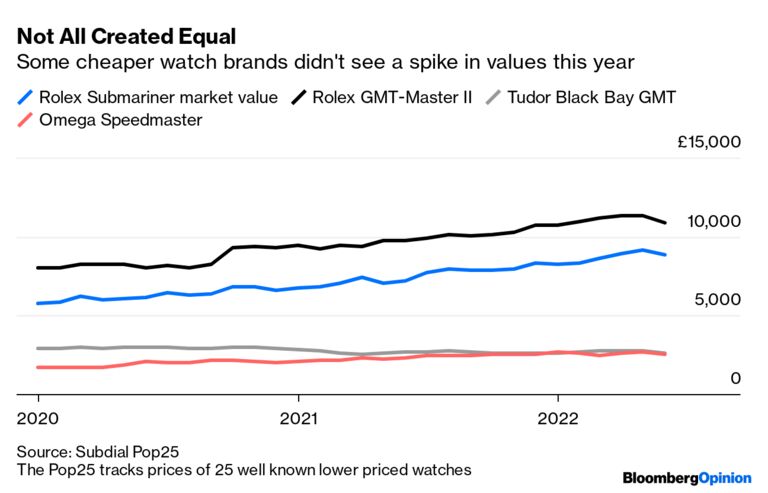Crypto Meltdown Claims Rolex and Patek Philippe as Victims
Prices for the most popular secondhand luxury watches have peaked. It’s the latest sign that the bling boom might not last.
Source: Bloomberg
The crypto meltdown has claimed its first luxury victim: the Rolex Daytona.
After reaching record highs earlier this year, prices for the most desirable watches on the secondary market, including the coveted Rolex, have now fallen.
The bubble in secondhand timepieces was fueled by a combination of crypto and stock-market gains, stimulus cash and speculation. That is now unravelling. So far, demand for both new watches and other types of luxury goods is holding up. But what’s happening in the secondary watch market is a stark reminder that the bling boom, particularly in the US, might not last.
Past the Peak
Although the secondary watch market has softened it has not given up all of the gains of the past two years
In 2021, a combination of roaring stock markets and cryptocurrencies bolstered wealth and ignited a broader interest in investing in alternative assets, whether non-fungible tokens or timepieces. And when markets began to whipsaw earlier this year, against the backdrop of rising inflation and geopolitical tensions, some investors were keen to put their money into more tangible stores of value, such as a Rolex. Consequently, a new breed of young timepiece traders joined long-time collectors.
Whether they were novices or old hands, buyers all chased the same models. By February or March, the holy trinity of the most hyped watches — the Rolex Daytona, the Patek Philippe Nautilus and the Audemars Piguet Royal Oak — was trading for many multiples of their retail prices. The skeletal pieces produced by Richard Mille were also highly sought after.
Holy Trinity of Hype
The value of the most desirable timepieces has tumbled
With the S&P 500 flirting with a bear market, and Bitcoin losing about 70% of its value since November, that demand is now evaporating. Buyers are becoming more cautious. Higher interest rates, the absence of stimulus payments and soaring inflation are playing a part. Lockdowns in China and fewer Russian buyers may also have increased supply.
The biggest reversals have been in the Daytona, Nautilus and Royal Oak — models that experienced the most spectacular gains. Prices are estimated to be about 25% below their peaks. This includes private transactions, though, and may not be reflected in available market data.
Deflationary
The average price of a Rolex in the secondary market has fallen since April
Some brands are faring better, including Cie Financiere Richemont SA’s Vacheron Constantin and A. Lange & Sohne, as some collectors diversified beyond or were priced out of the most obvious names. Some cheaper models, such as Rolex sister brand Tudor, did not see the same spikes as pricier marques. And there continues to be appetite for genuinely rare pieces, as opposed to those perceived as being simply scarce.
While the correction in the secondary market may make it a little cheaper to buy a Rolex, it might not necessarily make it easier to get hold of one.
Real Estate
Wenston DeSue is a realtor, organizational consultant, design, construct, build expert and developmental networker. Real estate is the business of exchange and affects every person on the planet. Real estate on all levels represents resources, access and ultimately, power. Knowledge is power…


No comments:
Post a Comment